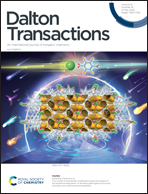Magnetic anisotropy of two tetrahedral Co(ii)-halide complexes with triphenylphosphine ligands†
Abstract
Recently, the choice of ligand and geometric control of mononuclear complexes, which can affect the relaxation pathways and blocking temperature, have received wide attention in the field of single-ion magnets (SIMs). To find out the influence of the coordination environment on SIMs, two four-coordinate mononuclear Co(II) complexes [NEt4][Co(PPh3)X3] (X = Cl−, 1; Br−, 2) have been synthesized and studied by X-ray single crystallography, magnetic measurements, high-frequency and -field EPR (HF-EPR) spectroscopy and theoretical calculations. Both complexes are in a cubic space group Pa![[3 with combining macron]](https://www.rsc.org/images/entities/char_0033_0304.gif) (No. 205), containing a slightly distorted tetrahedral moiety with crystallographically imposed C3v symmetry through the [Co(PPh3)X3]− anion. The direct-current (dc) magnetic data and HF-EPR spectroscopy indicated the anisotropic S = 3/2 spin ground states of the Co(II) ions with the easy-plane anisotropy for 1 and 2. Ab initio calculations were performed to confirm the positive magnetic anisotropies of 1 and 2. Frequency- and temperature-dependent alternating-current (ac) magnetic susceptibility measurements revealed slow magnetic relaxation for 1 and 2 at an applied dc field. Finally, the magnetic properties of 1 and 2 were compared to those of other Co(II) complexes with a [CoAB3] moiety.
(No. 205), containing a slightly distorted tetrahedral moiety with crystallographically imposed C3v symmetry through the [Co(PPh3)X3]− anion. The direct-current (dc) magnetic data and HF-EPR spectroscopy indicated the anisotropic S = 3/2 spin ground states of the Co(II) ions with the easy-plane anisotropy for 1 and 2. Ab initio calculations were performed to confirm the positive magnetic anisotropies of 1 and 2. Frequency- and temperature-dependent alternating-current (ac) magnetic susceptibility measurements revealed slow magnetic relaxation for 1 and 2 at an applied dc field. Finally, the magnetic properties of 1 and 2 were compared to those of other Co(II) complexes with a [CoAB3] moiety.



 Please wait while we load your content...
Please wait while we load your content...
